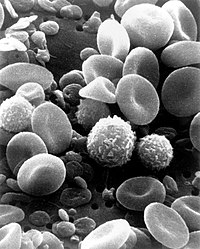
Photo from wikipedia
Radiotherapy of head and neck cancers frequently leads to irreversible hypofunction of salivary glands, which severely compromises the quality of life and is extremely difficult to treat. We found recently… Click to show full abstract
Radiotherapy of head and neck cancers frequently leads to irreversible hypofunction of salivary glands, which severely compromises the quality of life and is extremely difficult to treat. We found recently that salivary gland resident macrophages are sensitive to radiation and interact with epithelial progenitors and endothelial cells through homeostatic paracrine factors. Heterogeneous subpopulations of resident macrophages are present in other organs with distinct functions, whereas subpopulations of salivary gland resident macrophages with distinct functions or transcriptional profiles have not been reported yet. Using single-cell RNA sequencing, we found that mouse submandibular glands (SMGs) contain 2 distinct self-renewing resident macrophage subsets, an MHC-IIhi subset present in many other organs and an uncommon Csf2r+ subset. The main source of Csf2 in SMGs are innate lymphoid cells (ILCs) that rely on IL15 for maintenance, while the main source of IL15 protein is Csf2r+ resident macrophages, indicating a homeostatic paracrine interaction between these cells. Csf2r+ resident macrophages are the major source of hepatocyte growth factor (Hgf) that regulates homeostasis of SMG epithelial progenitors. Meanwhile, Csf2r+ resident macrophages are responsive to Hedgehog signaling that can rescue salivary function impaired by radiation. Consistently, irradiation persistently decreased numbers of ILCs and levels of IL15 and Csf2 in SMGs, which were all recovered by transient activation of Hedgehog signaling after radiation. Csf2r+ resident macrophages and MHC-IIhi resident macrophages share transcriptome profiles of perivascular macrophages and macrophages associated with nerves and/or epithelial cells in other organs, respectively, and such niche preferences were supported by lineage tracing and immunofluorescent staining. These findings reveal an uncommon resident macrophage subset that regulates the homeostasis of the salivary gland and is promising as the target to restore salivary gland function impaired by radiation.
Journal Title: Journal of Dental Research
Year Published: 2023
Link to full text (if available)
Share on Social Media: Sign Up to like & get
recommendations!